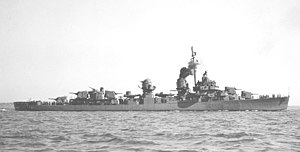USS Caperton

| |
| History | |
|---|---|
| Namesake | William B. Caperton |
| Builder | Bath Iron Works |
| Laid down | 11 January 1943 |
| Launched | 22 May 1943 |
| Commissioned | 30 July 1943 |
| Decommissioned | 27 April 1960 |
| Stricken | 1 December 1974 |
| Fate | Sunk as a target in the 1980s |
| General characteristics | |
| Class and type | Fletcher-class destroyer |
| Displacement | 2,050 tons |
| Length | 376 ft 6 in (114.7 m) |
| Beam | 39 ft 8 in (12.1 m) |
| Draft | 17 ft 9 in (5.4 m) |
| Propulsion |
|
| Speed | 35 knots (65 km/h; 40 mph) |
| Range |
|
| Complement | 319 |
| Armament |
|
USS Caperton (DD-650) was a
Caperton was
Service history
Caperton sailed from
Caperton cleared Espiritu Santo 15 March 1944 for the air operations covering the invasion of Emirau Island, then sailed for the stunning blows hurled from the air at the Japanese on Palau, Yap, Woleai, and Ulithi late in March. Tireless TF 58 continued the crescendo pace of its attacks, and in April Caperton screened air strikes preparatory to the invasion of Hollandia, saw the force's planes hit Truk once more, and blasted at Satawan and Ponape in shore bombardment.
On 6 June 1944, Caperton sortied from Majuro for the Marianas operation, which culminated in the fury of the Battle of the Philippine Sea on 19 and 20 June. Screening the American carriers as they launched the strikes which would cripple Japanese naval aviation, Caperton interposed her blazing antiaircraft fire between enemy air attacks and the carriers. Moving on to cover the attacks preparatory to the return of United States forces to Guam, Caperton sailed close inshore to provide lifeguard services for carrier strikes, and on 25 June braved the fire of enemy shore batteries to shell and sink a cargo ship in Apra Harbor. Through July, she operated in the Marianas, and late in the month screened air strikes on Yap and Palau.
Caperton got underway from Eniwetok 30 August 1944 to rendezvous with TF 38 for the well-planned bombardments and air strikes which paved the way for the return to the
Continued operations supporting the invasion of the Philippines kept Caperton at sea from her base at Ulithi. When Reno was torpedoed on 4 November 1944, Caperton took her injured and other survivors on board, and after weathering the furious typhoon of 18 December, she steamed for air strikes on Formosa, Luzon, Cam Ranh Bay, Hong Kong, Canton, and Okinawa.
An overhaul on the west coast prepared the destroyer for picket duty off Okinawa through May and June 1945. The desperate Japanese suicide air attacks made radar picket duty off embattled Okinawa one of the most dangerous duties of the war, but Caperton served her tour unscathed; constantly vigilant both to protect herself and provide for effective use of her radar warning equipment.
On 29 June 1945, Caperton rejoined TF 38 for the final air strikes on the Japanese home islands, which continued until the close of the war. After several months of occupation duty at Tokyo, Caperton returned to the east coast of the United States, where she was decommissioned at Charleston, South Carolina, 6 July 1946.
The battle-tried veteran was recommissioned 6 April 1951, as the fleet was augmented to meet the threat posed by the
Five months of operations with North Atlantic Treaty Organization forces in northern Europe in 1954, and a good-will visit to Guayaquil, Ecuador, in 1955 highlighted a period of local operations and training which preceded Caperton's patrol operations in the Atlantic during the Suez Crisis of November 1956. On 21 January 1957, Caperton sailed for a tour of duty with the 6th Fleet in the Mediterranean during which she sailed with the carrier striking force in the eastern Mediterranean during the Jordan crisis. Returning to Newport in June, the destroyer's next lengthy deployment was her participation from 3 September to 27 November in NATO Exercise Strikeback in the North Atlantic and Mediterranean. Operations off the east coast, in the Caribbean, with the 6th Fleet in the Mediterranean (including visits to Red Sea and Persian Gulf ports), and combined operations with Canadian forces continued through 1959. Caperton was placed out of commission in reserve at Norfolk, Virginia, on 27 April 1960.[1]
Awards
Caperton received 10
References
 This article incorporates text from the public domain Dictionary of American Naval Fighting Ships. The entry can be found here.
This article incorporates text from the public domain Dictionary of American Naval Fighting Ships. The entry can be found here. This article includes information collected from the Naval Vessel Register, which, as a U.S. government publication, is in the public domain. The entry can be found here.
This article includes information collected from the Naval Vessel Register, which, as a U.S. government publication, is in the public domain. The entry can be found here.
